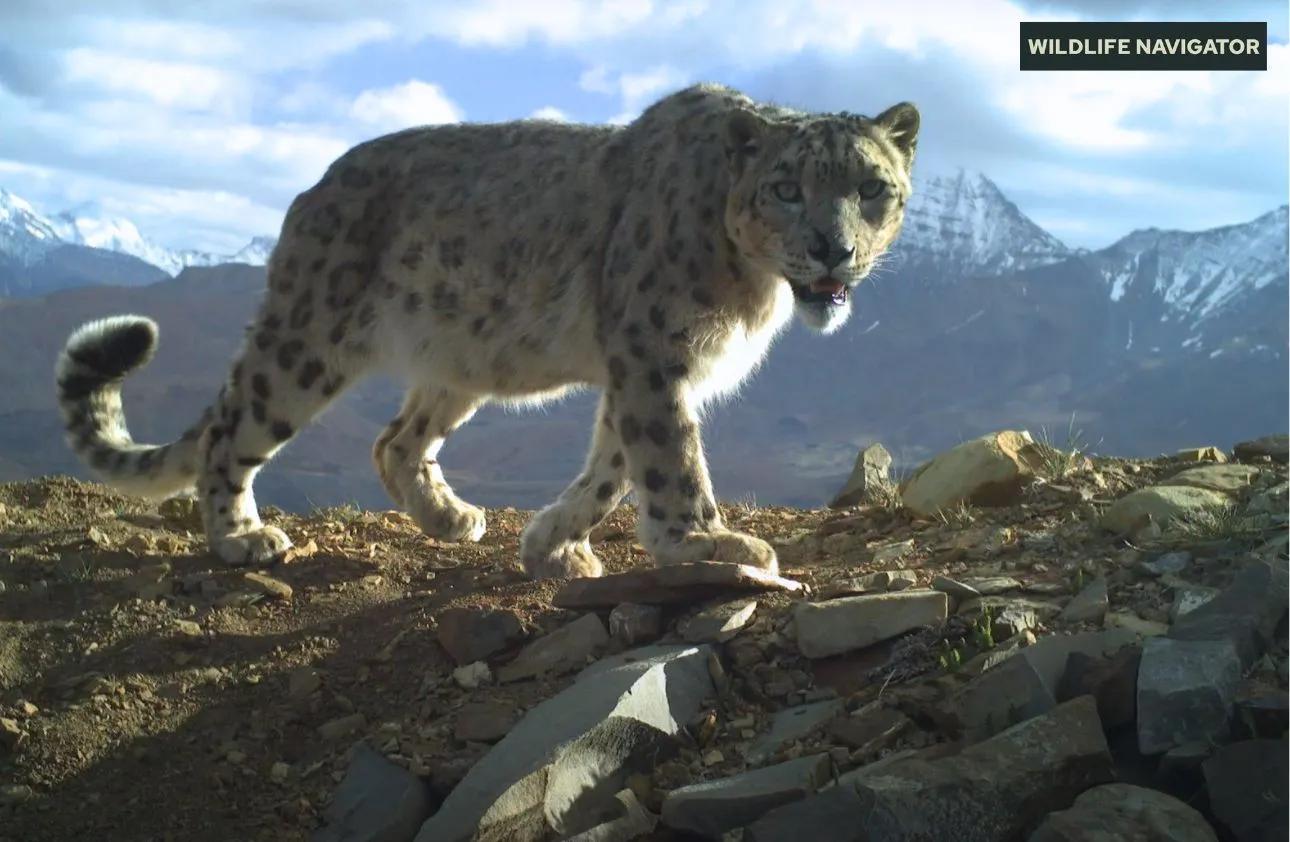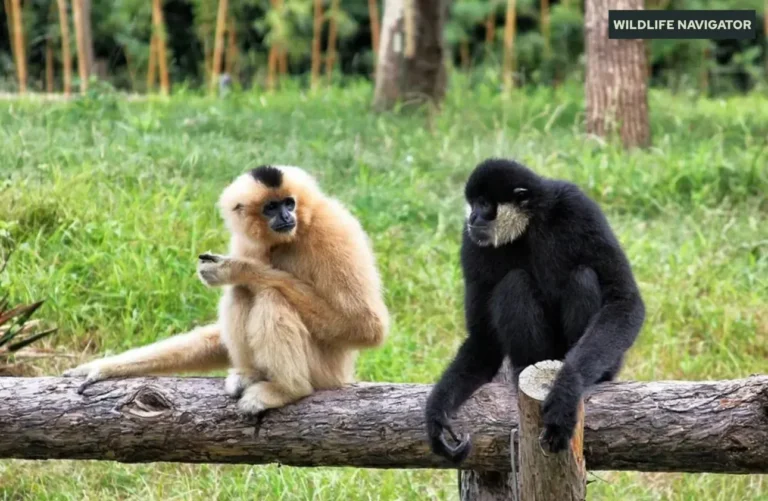Snow Leopard – The Ghost of the Mountains

The Snow Leopard (Panthera uncia) is one of the most elusive and mysterious big cats in the world, often called the “Ghost of the Mountains.” Known for its breathtaking beauty and unmatched ability to survive in some of the harshest environments on Earth, the snow leopard roams across the high mountain ranges of Central and South Asia. With its smoky-grey coat patterned with rosettes and spots, it blends seamlessly into rocky cliffs and snowy landscapes, making it almost invisible to the human eye.
This magnificent predator holds immense ecological importance as an apex carnivore, regulating prey populations like blue sheep and ibex, which in turn maintain the balance of alpine ecosystems. Beyond ecology, the snow leopard has deep cultural significance in the folklore, traditions, and beliefs of Himalayan communities, where it symbolises strength, resilience, and the spiritual connection between humans and mountains.
Yet, despite its revered status, the snow leopard remains one of the most endangered big cats. Its population faces severe threats from habitat loss, poaching, and climate change, which makes global conservation efforts vital. Studying and protecting the snow leopard is not just about saving a single species—it’s about preserving the fragile balance of entire mountain ecosystems.
1. Scientific Classification & Taxonomy
The Snow Leopard (Panthera uncia) belongs to the Felidae family, which includes all cats, from domestic species to the mighty tigers and lions. While it shares many similarities with leopards, tigers, and jaguars, the snow leopard stands apart due to its unique adaptations for cold, high-altitude environments.
Here’s the scientific classification of the snow leopard:
- Kingdom: Animalia
- Phylum: Chordata
- Class: Mammalia
- Order: Carnivora
- Family: Felidae
- Genus: Panthera
- Species: Panthera uncia
Interestingly, the snow leopard was once classified under the genus Uncia and called Uncia uncia. However, advances in genetic research proved its closer relationship to other big cats within the Panthera genus. This reclassification also highlights that snow leopards, despite their name, are genetically closer to tigers than to leopards.
Unlike other members of the Panthera genus, snow leopards cannot roar in the same deep, resonant way as tigers or lions. Their vocalisation is more of a chuffing or mewling sound, adapted for communication in steep, echoing mountain valleys.
Taxonomy plays a key role in conservation, as genetic studies reveal population diversity and connections between snow leopards across different mountain ranges. Such insights help scientists decide whether there may be subspecies or distinct populations, which can affect how conservation strategies are designed at local and global levels.
2. Physical Characteristics of the Snow Leopard
The Snow Leopard (Panthera uncia) is a medium-sized big cat, uniquely adapted to survive in the rugged, high-altitude environments of Central and South Asia. Adult snow leopards typically weigh between 27 to 55 kilograms (60–120 lbs), with males being larger than females. They measure around 86 to 125 cm (34–49 inches) in body length, excluding their exceptionally long tails that add another 80 to 100 cm (31–39 inches). This tail is not just for balance while navigating steep cliffs but also acts as a warm covering when curled around the body during freezing nights.
Their thick, smoky-gray fur, marked with dark rosettes and spots, provides perfect camouflage against rocky terrains and snowy landscapes. The coat changes with the seasons, becoming thicker and lighter in winter for insulation and slightly shorter in summer. Snow leopards have a dense woolly undercoat beneath the outer layer, making them well-suited to survive temperatures as low as –40°C.
One of their most striking features is their large, powerful paws, which act like natural snowshoes by distributing weight evenly across snow. Their short forelimbs and long hindlimbs give them extraordinary jumping power, allowing them to leap as far as 15 meters (50 feet) in a single bound—an essential skill for hunting agile mountain prey like blue sheep and ibex.
With their compact body, stocky build, and keen eyesight, snow leopards are the ultimate symbol of stealth, power, and survival in some of the world’s harshest habitats.
3. Habitat & Geographic Distribution of the Snow Leopard
The Snow Leopard (Panthera uncia) is a true mountain predator, perfectly adapted to the rugged terrains of Central and South Asia. These elusive cats are typically found at elevations ranging from 3,000 to 5,500 meters (9,800–18,000 feet), where steep cliffs, rocky ridges, and sparse alpine meadows dominate the landscape. Such high-altitude habitats provide them with both natural camouflage and access to their preferred prey species.
Snow leopards have one of the largest and most challenging distribution ranges of any big cat, spanning across 12 countries: Afghanistan, Bhutan, China, India, Kazakhstan, Kyrgyzstan, Mongolia, Nepal, Pakistan, Russia, Tajikistan, and Uzbekistan. Among these, China holds nearly 60% of the global population, followed by Mongolia and India.
Within India, snow leopards are mainly found in the Himalayan states of Ladakh, Himachal Pradesh, Uttarakhand, Arunachal Pradesh, and Sikkim. The cold deserts of Ladakh and Spiti Valley are considered strongholds for the species.
These big cats prefer arid, treeless landscapes, often choosing rocky outcrops and cliffs for denning sites. The rugged terrain not only protects them from threats but also provides vantage points for ambushing prey. Seasonal movements are also common—during summer, they stay at higher altitudes, while in winter, they descend to lower valleys following migrating prey.
4. Behaviour & Lifestyle of the Snow Leopard
The Snow Leopard (Panthera uncia) is a solitary and secretive big cat, perfectly adapted to life in remote mountain landscapes. Unlike lions or tigers, snow leopards are primarily crepuscular, meaning they are most active during dawn and dusk. This behaviour allows them to hunt effectively while avoiding the harshest daylight temperatures in alpine regions.
Each snow leopard maintains a large home range, which can cover up to 200 square kilometres, depending on prey availability. They mark their territories with scent, scratch marks, and scat, often choosing prominent rocks and ridges as communication points. Despite their solitary nature, overlapping territories are common, and they usually avoid direct conflict by adjusting their movements.
Snow leopards are extremely elusive, often earning the nickname “Ghost of the Mountains” due to their stealth and ability to disappear into rocky landscapes. They rely heavily on their keen eyesight and camouflage to stalk prey undetected.
Interestingly, snow leopards cannot produce the deep roar typical of other big cats in the Panthera genus. Instead, they communicate through hisses, growls, mews, and a unique non-roaring call known as a “chuff.”
Their lifestyle is finely tuned to survival in harsh conditions—solitude, stealth, and silence are their greatest strengths.
5. Diet & Hunting Techniques of the Snow Leopard
The Snow Leopard (Panthera uncia) is a skilled predator, relying on stealth, patience, and powerful leaps to secure its meals in rugged mountain habitats. Its diet primarily consists of wild ungulates, with blue sheep (bharal) and ibex making up the bulk of its prey. In regions like Ladakh and Spiti, Himalayan tahr, argali, and markhor are also important food sources. Smaller mammals such as marmots, pika, and hares, along with game birds like snowcocks and chukars, provide additional variety, especially when large prey is scarce.
Snow leopards are ambush hunters, using rocky cliffs and ridges as cover. They rely on their exceptional camouflage to approach prey quietly before launching a sudden, explosive attack. With their powerful hind legs, they can leap up to 15 meters (50 feet) in a single bound, a crucial adaptation for capturing agile mountain-dwelling animals.
Unlike many predators, snow leopards are capable of taking down prey three times their own body weight. After a successful kill, they often drag the carcass to a secluded spot, feeding on it for several days. This behaviour helps maximise energy gained from each hunt in an environment where food is scarce.
However, snow leopards also display remarkable adaptability. In areas where wild prey populations have declined due to human activities, they sometimes turn to livestock such as sheep, goats, and yaks, which often leads to conflict with herders.
6. Snow Leopard Reproduction & Life Cycle
The Snow Leopard (Panthera uncia) has a relatively short breeding season and a challenging reproductive cycle, influenced by its harsh mountain environment. Mating usually occurs between January and March, when snow leopards descend to lower altitudes. This timing ensures that cubs are born during summer, when conditions are less severe and prey is more abundant.
After a gestation period of 90–100 days, the female gives birth to a litter of 1–3 cubs, usually in a well-hidden rocky den lined with her thick fur for warmth. Cubs are born blind and helpless, relying completely on their mother for survival. By the age of 2 months, they begin eating solid food, though they continue nursing for several more weeks.
The mother raises her cubs alone, fiercely protecting and teaching them essential survival skills. Cubs stay with her for about 18–22 months before dispersing to establish their own territories. Sadly, cub mortality is high due to predators, harsh weather, and scarcity of prey.
In the wild, snow leopards live around 12–15 years, while in captivity, they may survive up to 20 years. Their slow reproduction rate, combined with environmental pressures, makes population recovery a significant conservation challenge.
7. Species & Subspecies Debate of the Snow Leopard
The Snow Leopard (Panthera uncia) is generally considered a single species, but researchers have long debated whether distinct subspecies exist based on regional variations in size, coat patterns, and genetic differences. Recent molecular studies suggest that snow leopards across their range are genetically similar, but some experts still recognise potential subspecies for conservation purposes.
7.1 Panthera uncia uncia
Found primarily in the Himalayas of India, Nepal, Bhutan, and Pakistan, this population is considered the “classic” snow leopard. They tend to be larger with thick, pale gray fur and pronounced rosettes for camouflage in snowy alpine environments.
7.2 Panthera uncia uncioides
Native to the mountains of Mongolia, Russia, and northern China, this group is slightly smaller and adapted to the colder, drier climates of the Central Asian ranges. Their fur is often denser, and their rosettes are smaller and more irregular.
7.3 Panthera uncia irbis (sometimes debated)
Occasionally proposed as a distinct population in Tian Shan and Altai mountains, these snow leopards show subtle morphological differences, such as broader paws and lighter coat colouration. However, genetic evidence is still inconclusive, and many researchers classify them under the main species.
While these classifications exist, conservation efforts typically focus on preserving populations across their entire range, rather than differentiating subspecies. This is because habitat fragmentation, poaching, and climate change affect all snow leopard populations similarly, making unified strategies more practical and impactful.
8. Role in Ecosystem & Threats to Survival of the Snow Leopard
The Snow Leopard (Panthera uncia) plays a crucial role in maintaining the delicate balance of mountain ecosystems. As an apex predator, it regulates populations of herbivores like blue sheep, ibex, and Himalayan tahr. By keeping these prey populations in check, snow leopards prevent overgrazing, allowing alpine vegetation to thrive and supporting the overall health of fragile high-altitude habitats. In this way, the snow leopard acts as a keystone species, indirectly influencing biodiversity across the ecosystem.
Despite its ecological importance, the snow leopard faces numerous threats. Poaching for fur and body parts, habitat loss due to human encroachment, and retaliatory killings by herders whose livestock are preyed upon are major challenges. Climate change also poses a long-term threat, as rising temperatures shift vegetation zones and reduce prey availability. Fragmented habitats make it harder for snow leopards to find mates and maintain genetic diversity, increasing the risk of population decline.
9. Conservation Status & Efforts for the Snow Leopard
The Snow Leopard (Panthera uncia) is currently listed as Vulnerable on the IUCN Red List, with an estimated 4,000 to 6,500 individuals remaining in the wild. Its population is fragmented across high-altitude regions in 12 countries, making monitoring and protection particularly challenging. The species’ elusive nature and remote habitat have historically made population assessments difficult, but advances in camera trapping, GPS collars, and genetic studies have provided more accurate insights into their numbers and movements.
9.1 Global Conservation Programs
International efforts, such as the Global Snow Leopard & Ecosystem Protection Program (GSLEP), focus on safeguarding snow leopard habitats and promoting transboundary cooperation between countries. These programs emphasise scientific research, anti-poaching initiatives, and community-based conservation strategies that engage local populations in protecting wildlife.
9.2 Local and Community-Based Efforts
In India, Project Snow Leopard works to conserve habitats in the Himalayan states while balancing human needs. Community-based programs compensate herders for livestock losses and promote eco-tourism, providing economic incentives to protect rather than harm snow leopards. Non-governmental organisations like the Snow Leopard Trust support similar initiatives across Mongolia, Nepal, and Bhutan.
Through coordinated international and local efforts, these programs aim not only to stabilise snow leopard populations but also to preserve the fragile mountain ecosystems they inhabit, ensuring the survival of this iconic predator for future generations.
10. Cultural & Mythological Significance of the Snow Leopard
The Snow Leopard (Panthera uncia) holds a special place in the cultural and spiritual traditions of Himalayan and Central Asian communities. Revered for its elusive nature and silent grace, it is often seen as a symbol of strength, mystery, and resilience. In Tibetan folklore, the snow leopard is considered a guardian of the mountains, representing protection and spiritual guidance.
In Mongolia and parts of Central Asia, the snow leopard appears in traditional stories as a clever and powerful creature, teaching lessons about patience, cunning, and survival. Local herders often respect the snow leopard, acknowledging its role in maintaining the ecological balance of their grazing lands, though conflicts over livestock occasionally arise.
Beyond folklore, the snow leopard has inspired modern art, literature, and conservation campaigns, becoming a global icon for endangered wildlife. Its image is used to promote eco-tourism, raise awareness about climate change, and highlight the fragility of high-altitude ecosystems. Protecting the snow leopard is not only a conservation priority but also a way of preserving cultural heritage intertwined with the mountains it calls home.
11. Where to See Snow Leopards: Zoos and National Parks
Although the Snow Leopard (Panthera uncia) is notoriously elusive in the wild, there are several places where enthusiasts can observe this magnificent predator safely. In the wild, prime habitats include Himalayan regions of India, Nepal, Bhutan, and Ladakh, as well as Central Asian mountain ranges like the Tien Shan, Altai, and Pamirs. National parks and reserves offer the best opportunities for sightings, though encounters are still rare due to their secretive nature.
11.1 Notable National Parks & Reserves in the Wild
- Hemisphere of India: Hemis National Park (Ladakh), Khangchendzonga National Park (Sikkim), and Great Himalayan National Park (Himachal Pradesh).
- Nepal: Annapurna Conservation Area, Langtang National Park.
- Bhutan: Jigme Dorji National Park, Wangchuck Centennial Park.
11.2 Zoos & Wildlife Sanctuaries
For those who want to see snow leopards without trekking high mountains, several zoos around the world maintain healthy populations:
- India: Padmaja Naidu Himalayan Zoological Park (Darjeeling), Himalayan Zoological Park (Gangtok).
- International: Bronx Zoo (USA), San Diego Zoo (USA), and Edinburgh Zoo (UK).
These facilities contribute to education, research, and captive breeding programs, helping raise awareness and support for global snow leopard conservation efforts.
12. Conclusion
The Snow Leopard (Panthera uncia) is more than just a majestic mountain predator—it is a symbol of resilience, mystery, and ecological balance. From its silent hunts across rugged alpine landscapes to its role as a keystone species regulating herbivore populations, the snow leopard is vital to the health of high-altitude ecosystems. Yet, its survival is under constant threat from poaching, habitat loss, and climate change, making global and local conservation efforts more crucial than ever.
Protecting snow leopards is not just about saving a single species; it is about safeguarding entire mountain ecosystems, preserving biodiversity, and maintaining the cultural and spiritual heritage of the Himalayan and Central Asian communities that revere this extraordinary cat. Through research, community engagement, eco-tourism, and international cooperation, we can ensure that the “Ghost of the Mountains” continues to roam its snowy realms for generations to come.





